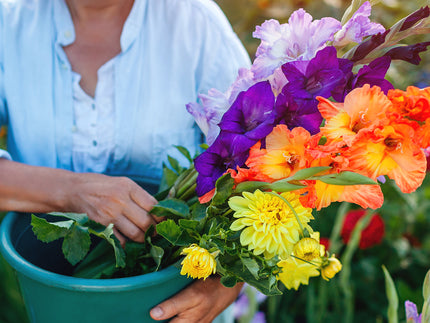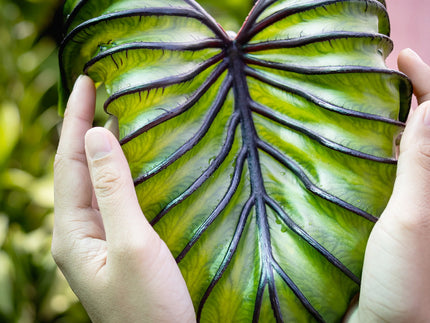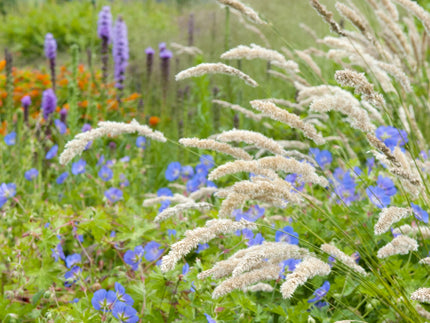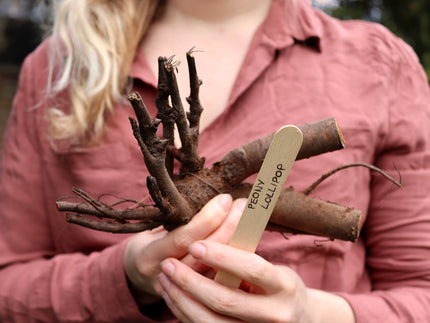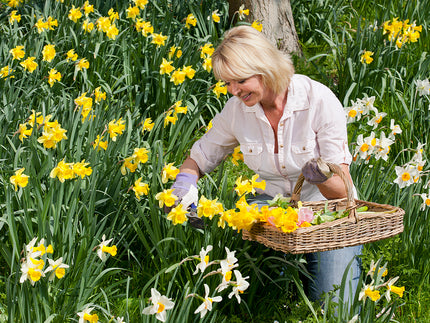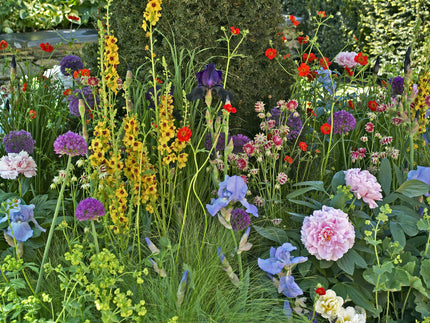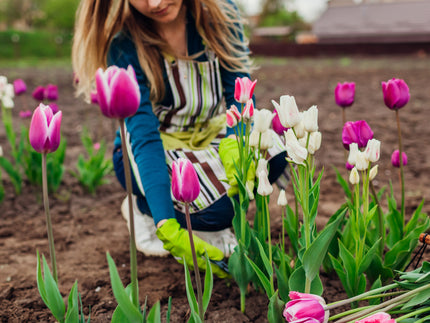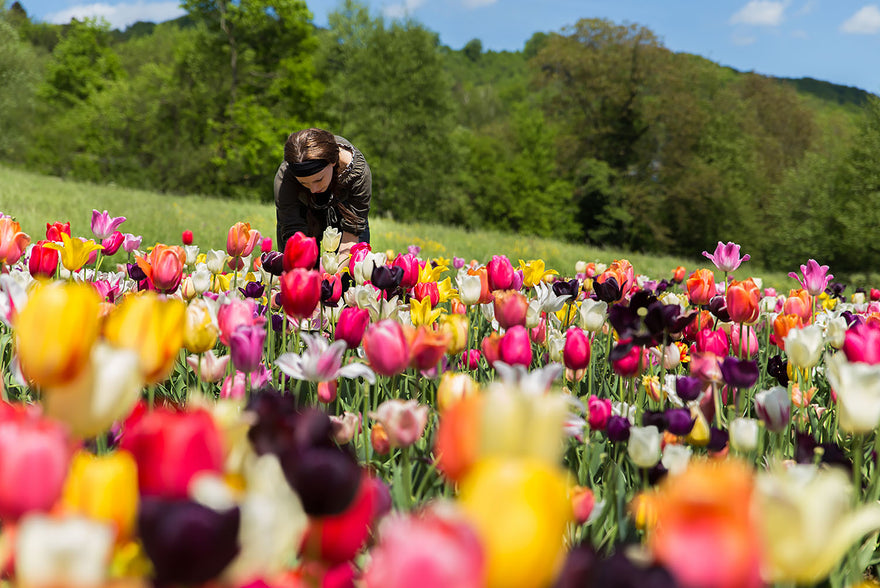
Tulips — all you need to know about tulip bulbs
When thinking of spring flowers, tulips are often the first to come to mind. The vast array of colours, shapes and the generous flowering season really do make them such an asset in the garden. They are so versatile and incredibly easy to grow, providing a cheery and low maintenance surge of colour to the garden. Whether you are looking for a festival of colour or a chic elegant affair, this genus really does have something for everyone.
History of the tulip
The tulip can be traced as far back as the 16th century in Kazakhstan. They were found growing wild in the mountains during the Ottoman Empire (present day Turkey) where they were harvested and planted in the gardens of the most powerful people. Sultan Suleyman the First was so captured by their beauty, that he would gift them to his important guests and as a gesture of wealth. They also wore a tulip in their turbans—in fact, the Persian word for turban is tulipan.
It was during 1593 that Carolus Clusius, who at the time managed the gardens of the Emperor of Austria, was gifted some tulips by the Viennese ambassador. Clusius later became head of the Hortus Botanicus in Leiden and it was in this botanical garden that the first tulips were planted in the Netherlands! However, the tulips drew too much attention and one morning Clusius found the tulips had been stolen from the garden—and so began the Dutch trade in tulips!

Soon, tulip craze burst and the demand saw prices soar. People would pay as much for a single bulb as they would an Amsterdam canal house! By 1637, however, the bubble burst when the government ended the trade in tulips leaving many people very rich and many with nothing at all.
Today the tulip remains the most important flower in Dutch history—thankfully, we no longer need to sell our homes to own these incredible flowers. With over 150 species and thousands of hybrids, they fill almost half the bulb fields in the Netherlands and offer the most dazzling choice for gardeners to add that touch of Dutch history to their own gardens.
Types of tulips / Tulip groups
There are so many tulip varieties and choosing can feel a little overwhelming! You can focus on colour, flower shape, height, flowering period, or if you want them to come back each year.
Species and kaufmanniana tulips—also known as botanical tulips, these will flower year on year. These are most often smaller than their hybridised cousins however they are delicate and have an elegance all of their own. They will naturalise in your garden under the right conditions. The foliage is more varied than the hybrids and can often produce multiple blooms per stem.
On the other hand, there are hybrid tulips which are big, impressive and colourful. These tulips are usually replaced each season as they have tendency to run out of vigour after the first year and gradually the blooms will become smaller and less colourful.
Tulips are split into different groups depending on the flowering season and flower shape:
Group 1 — Single early tulips
Single flowers, cup shaped and among the first to flower, opening wide in full sun.

Group 2 — Double early tulips
Double flowered, usually short stems and early to flower. Great for cut flowers with heads up to 10cm wide, open wide in full sun and long lasting.

Group 3 — Triumph tulips
Single conical flowers, sturdy stems, mid-season. The result of hybridisation between single early and single late. Long lasting cut flower properties. Blooms up to 7cm wide.

Group 4 — Darwin hybrid tulips
Large single flowers on long strong stems, flowering in mid to late season (April/May). These have huge, goblet-like flowers up to 15cm across. Darwin tulips are perennial.

Group 5 — Single late tulips
Single-flowered cultivars, mainly long strong stemmed and flowering late spring, and very early summer, usually with pointed petals.

Group 6 — Lily-flowered tulips
Single narrow waisted flowers, flowering mid-season or late, strong stems with varying lengths.

Group 7 — Fringed tulips (Crispa tulips)
Single-flowered cultivars, similar to lily-flowering tulips but petals are fringed, flowering mid-season or late. Stem of variable length.

Group 8 — Viridifolia tulips
These are distinguished by the green streaks or markings on their petals and are normally late season.

Group 9 — Rembrandt tulips
Flowers are similar to group 6 but have flame marking on their petals caused by a non-spreading virus. Long-stemmed.

Group 10 — Parrot tulips
Flowers are large and variable with unusual fringed, curled and twisted petals. Mainly late season. Stems of variable length. These large flowers can also be bi-coloured.

Group 11 — Double late tulips or peony tulips
These have large, fully double bowl-shaped flowers up to 12cm wide.

Group 12 — Fosteriana tulips
Early-flowering variety with broad leaves which can be sometimes mottled or striped. Stems medium to long. These have slender flowers which open flat in full sun to approx. 18-20cm wide.

Group 13 — Species tulips or botanical tulips
Perennial diverse species of tulip, also known as botanical tulips. These are smaller and more delicate than modern hybrids, but are normally very hardy and long lived.

Group 14 — Kaufmanniana tulips
One of the most permanent tulip varieties. These have lily-like flowers which flatten out when open in full sun and can be bi-coloured and/or have striped or mottled leaves.

Group 15 — Greigii tulips
Usually marbled or striped foliage with a wavy edge, flowering later than those in the Kaufmanniana group. Near permanent variety, coming up year after year. These have large brightly coloured flowers.

The below illustration shows some of the different types and their flowering time, which is useful for planning a succession of tulips for your garden.

Planting tulips
Planting tulips is really very easy. As a rule of thumb, they need to be planted in a hole approximately three times their height and approximately twice their width apart from each other, which is roughly 10-15cm.
— The best time to plant is during autumn, although tulips will be happy planted right up until mid-December provided the soil is not waterlogged or frozen. It is always best to ensure your bulbs are planted at the appropriate time. Planting later than December comes with a risk that the bulbs will be dehydrated or completely deteriorated.
— Tulips can be grown in borders and containers, most are often grown as annual bedding plants. Alternatively, botanical, kaufmannia and darwin hybrid tulips are perennials and will grow back every year. Botanical tulips can be naturalised in grass, offering perpetual interest during spring. Botanical tulips look great in meadows and gravel gardens as well as pots and borders.
— Tulips prefer a well-drained, fertile soil and will be happiest in sun and part shade. They all prefer not to be in overly wet conditions and like a sheltered spot in the garden. If you have a clay soil or particularly gravelly, incorporate some humus-rich organic matter to improve its consistency. Where the soil is very heavy clay, including some coarse grit or gravel will help with drainage around the bulb.
— It is important to make sure your bulbs are healthy when planting, so check for any damage, or signs of deterioration such as softening or developing moulds. Any that appear in poor health should be discarded.

Spacing tulips
Working out how many tulips you'll need depends on which type you have chosen and how you are planning to display them.
— If you are interplanting your tulips in borders with bedding or small bulbs, you can space them around 20cm apart from each other. If you are creating a solid blocks of colour or drifts in border, it is best to go by a spacing of around 10-15cm. Per square metre, we recommend planting 60 bulbs for a dense display.
— When planting tulips in pots, closer together is better. You can plant them as close as 5cm apart from each other to create a really showy, full container.
— If planting small botanical tulips, they will need to be planted at a spacing of around 5cm to create a dense display, whether they are in pots or a border. If you were planting a square metre of botanical tulips in a border, we recommend planting around 100 bulbs.
Tulip aftercare
When growing your tulips in pots, be aware that they should not be left very wet in the compost over winter. If you notice this is the case, relocate your pot to a more sheltered position where the soil will have a chance to dry out a little and ensure the drainage hole is not blocked. The combination of the cold as well as the wet soil could cause your bulbs to rot.
— On the converse, once the weather begins to warm in spring, ensure your pots do not dry out as this may cause poor development and early withering of your beautiful blooms! Pots can dry out very quickly, but if growing the bulbs in the border they will not require additional watering unless it's extremely dry in spring.
— Bulbs can be fed to promote healthy growth and flowering, but it isn't usually necessary. If you have tulip bulbs saved from previous years, it may be beneficial to apply a tomato feed on a weekly basis once they are in growth and until the foliage begins to yellow and die back.
— Once your tulips have finished flowering, there are options as to what you should do with them. Hybrid tulips flower best in their first year and may or may not return reliably in the second year. It is recommended to remove these bulbs from your best pots after flowering, but they can be transferred immediately to a less significant part of the garden while the foliage dies back. This should be an informal space where they can do as they please, hopefully they'll provide a bonus splash of colour next year.

— It is believed that lifting tulip bulbs, drying them and storing them over summer then replanting them in autumn, increases their chances of returning in the following year. If you decide to try this, ensure that the flower is deadheaded before it forms a pod and the stem and foliage has turned yellow before it is removed and the bulbs are lifted—any green parts, especially the stem, are transferring energy to the bulb for next year. Also, you will need to expect that even when lifted and stored, some bulbs will not grow back the next year and some may not flower as extravagantly as they did in the first year.
— In the case of species/botanical, kaufmannia and darwin hybrid tulips, they are perennial and will return every year providing the leaves and stems are allowed to turn yellow or die back naturally. It's essential that any greenery is left intact so that the bulbs have enough energy to flower next year. These tulips prefer to stay planted all year round. Darwin and kaufmannia tulips should be deadheaded after flowering, cutting the stem just below the flower. If you want botanical tulips to naturalise, avoid deadheading and their flowers can set seed and spread.
Common problems
Much like any other plant, tulips can be prone to pest and diseases. To avoid this from the outset, we only supply top-quality bulbs from reputable growers. They are regularly inspected for pests and diseases and sent to you at the appropriate time of year.
Natural deterioration of the bulbs — can occur rapidly from around mid December. Whilst Tulips are one bulb type that can tolerate a late planting window, we always recommend planting by mid December to give them the best opportunity to develop and flower to their best ability.
Tulip fire — occurs when the bulbs are planted too early in the autumn while the soil is still warm. This is why it is common practise to wait until late October before beginning to plant tulips. Tulip fire is a fungal disease caused by Botrytis tulipae which causes the foliage of the tulip to twist, wither and distort whilst also developing brown spots, the flowers may be empty or malformed. It is called Tulip Fire as it causes the foliage to appear scorched. Symptoms are apparent when the leaves emerge in spring and remain until dieback. Tulips showing signs of Tulip Fire should be entirely removed before they contaminate the soil for future years.
Squirrels — a perennial problem for many gardeners and not only relating to Tulips! The best way to protect your bulbs when in containers is to include a layer of chicken wire either on the top of the pot or a few inches beneath the soil – this allows for you to plant bedding over the top. This will create a challenge for the squirrels to negotiate and protect your precious bulbs. In open ground, plant the bulbs in aquatic baskets with chicken wire over the top and plant these at the appropriate depth – the same logic applies and these can be easily lifted once flowering has finished.
Failure to flower — this may be due to a lack of nutrients in the bulb, particularly where you are replanting for a second year but may also be due to shallow planting. Late planting may also affect the bulbs ability to develop and flower correctly.

















































































































































































